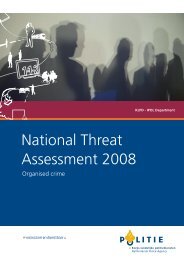Assessing the Effectiveness of Organized Crime Control Strategies ...
Assessing the Effectiveness of Organized Crime Control Strategies ...
Assessing the Effectiveness of Organized Crime Control Strategies ...
Create successful ePaper yourself
Turn your PDF publications into a flip-book with our unique Google optimized e-Paper software.
<strong>Assessing</strong> <strong>the</strong> <strong>Effectiveness</strong> <strong>of</strong> <strong>Organized</strong> <strong>Crime</strong> <strong>Control</strong> <strong>Strategies</strong>:<br />
A Review <strong>of</strong> <strong>the</strong> Literature<br />
nearly all <strong>of</strong> which is attributable to <strong>the</strong> suspicion-based ra<strong>the</strong>r than significant transaction<br />
reports. Suspicion-based reports are usually triggered by <strong>the</strong> structuring <strong>of</strong> transactions below<br />
<strong>the</strong> $10,000 threshold (or smurfing), international transfers <strong>of</strong> substantial amounts <strong>of</strong> cash, and<br />
cash transactions involving those who are not regular clients <strong>of</strong> <strong>the</strong> branch (Levi, 1997:10). A<br />
review in 1992 indicated that less than 10 percent <strong>of</strong> reports result in any direct action by law<br />
enforcement or taxation authorities (Levi, 1997:9).<br />
By contrast, in Canada, just over 100 cases have been referred to <strong>the</strong> RCMP by FINTRAC, <strong>the</strong><br />
new Canadian center that tracks financial transactions (Cordon, 2003:A12B). As <strong>the</strong> new<br />
Proceeds <strong>of</strong> <strong>Crime</strong> Act and Terrorism Financing Act that led to <strong>the</strong> creation <strong>of</strong> this center have<br />
only been introduced two years ago, it is too early to draw conclusions about its impact. The<br />
reporting <strong>of</strong> suspicious financial transactions did not begin until November, 2001 (Auditor<br />
General <strong>of</strong> Canada, 2003). In 2004, <strong>the</strong> Auditor General will report on <strong>the</strong> implementation <strong>of</strong><br />
<strong>the</strong>se new laws.<br />
Overall, Levi (1997:11) concludes that while <strong>the</strong> impact <strong>of</strong> money-laundering regulations cannot<br />
be determined, <strong>the</strong>y serve certain investigative and symbolic ends:<br />
[laundering regulations] appear to be most useful as an ex post facto audit trail for<br />
following through known leads. As for Australia, existing reviews suggest that<br />
insufficient use is being made <strong>of</strong> what I regard as <strong>the</strong> most technologically advanced<br />
set <strong>of</strong> controls…One <strong>of</strong> <strong>the</strong> core common issues internationally seems to be that<br />
many enforcement insiders assumed that once <strong>the</strong>y got <strong>the</strong> banks on <strong>the</strong>ir side…cases<br />
would just fall into <strong>the</strong>ir lap since banks already knew about <strong>the</strong>ir customers’ crimes.<br />
[In reality] all one has is an “out <strong>of</strong> character” financial transaction, <strong>the</strong> explanation<br />
<strong>of</strong> which usually cannot be simply sought from <strong>the</strong> parties involved, if <strong>the</strong>y are<br />
thought to be criminals…insufficient police or customs staffing has been devoted to<br />
<strong>the</strong>m: a common problem <strong>of</strong> inadequate resourcing for police functions. In this<br />
sense, money-laundering legislation could be viewed as being at <strong>the</strong> symbolic end <strong>of</strong><br />
<strong>the</strong> symbolic-instrumental legislation axis…<br />
The impact <strong>of</strong> money-laundering laws may be even more modest when one examines <strong>the</strong> results<br />
<strong>of</strong> those investigations that deal strictly with criminal enterprises.<br />
While <strong>the</strong> jury is still out in terms <strong>of</strong> <strong>the</strong> impact <strong>of</strong> money-laundering laws and <strong>the</strong> evidence to<br />
date is not reassuring, a number <strong>of</strong> investigations are noteworthy in <strong>the</strong>ir disruption <strong>of</strong> criminal<br />
activities. Two examples are those <strong>of</strong> Operation Greenback and <strong>the</strong> “Pizza Connection” case.<br />
Operation Greenback, for example, was <strong>the</strong> first US government task force concentrating on<br />
money laundering. Referred to as <strong>the</strong> first successful attempt to take <strong>the</strong> pr<strong>of</strong>it out <strong>of</strong> drug<br />
trafficking, it was initiated in 1980 and, during its first three years, <strong>the</strong> project produced 40<br />
indictments against 152 individuals from 40 organizations. One hundred and eleven people were<br />
arrested and $33 million in US currency seized. The project yielded millions <strong>of</strong> dollars <strong>of</strong><br />
additional seizures in property, as well as substantial amounts forfeited (Dombrink and Meeker,<br />
1987: 729). In <strong>the</strong> “Pizza Connection” case, an elaborate scheme was set up to launder <strong>the</strong><br />
proceeds <strong>of</strong> heroin smuggled from Sou<strong>the</strong>ast Asia and distributed in <strong>the</strong> eastern US by <strong>the</strong><br />
26 | Research and Statistics Division / Department <strong>of</strong> Justice Canada








